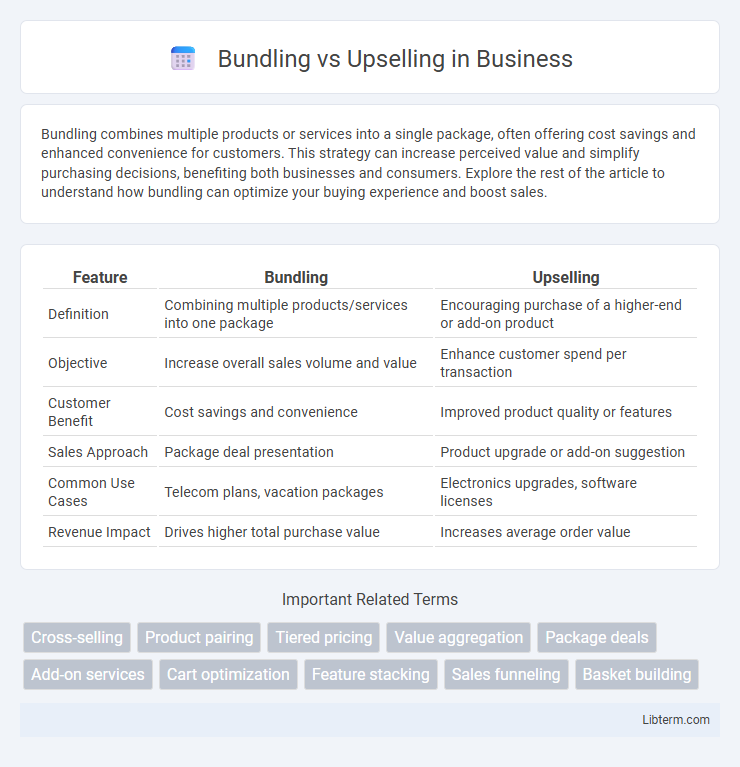Bundling combines multiple products or services into a single package, often offering cost savings and enhanced convenience for customers. This strategy can increase perceived value and simplify purchasing decisions, benefiting both businesses and consumers. Explore the rest of the article to understand how bundling can optimize your buying experience and boost sales.
Table of Comparison
| Feature | Bundling | Upselling |
|---|---|---|
| Definition | Combining multiple products/services into one package | Encouraging purchase of a higher-end or add-on product |
| Objective | Increase overall sales volume and value | Enhance customer spend per transaction |
| Customer Benefit | Cost savings and convenience | Improved product quality or features |
| Sales Approach | Package deal presentation | Product upgrade or add-on suggestion |
| Common Use Cases | Telecom plans, vacation packages | Electronics upgrades, software licenses |
| Revenue Impact | Drives higher total purchase value | Increases average order value |
Introduction to Bundling and Upselling
Bundling combines multiple products or services into a single package, often at a discounted price, to increase perceived value and boost sales volume. Upselling encourages customers to purchase a higher-end product or add extra features to maximize order value and enhance customer experience. Both strategies leverage consumer buying behavior to optimize revenue and drive business growth across various industries.
Defining Bundling: Concepts and Examples
Bundling involves offering multiple products or services together at a combined price, enhancing customer value and increasing sales volume. Common examples include telecommunication packages combining internet, phone, and TV services or software suites offering various applications within one purchase. This strategy leverages the perceived savings and convenience to attract buyers, differentiating it from upselling, which focuses on encouraging customers to purchase higher-end versions or add-ons.
Understanding Upselling: Strategies and Benefits
Upselling involves encouraging customers to purchase a more expensive or upgraded version of a product or service, leveraging techniques such as personalized recommendations and highlighting added value. Effective upselling strategies increase average order value and enhance customer satisfaction by aligning offers with individual needs and preferences. Businesses that master upselling benefit from higher revenue, improved customer loyalty, and more efficient sales processes.
Key Differences Between Bundling and Upselling
Bundling involves offering multiple products or services together at a combined price to increase perceived value and encourage larger purchases, while upselling focuses on persuading customers to buy a higher-end version or add-ons to enhance the primary product. Bundling targets expanding the overall sale with complementary items, whereas upselling aims to increase the transaction value by upgrading or adding features. Key differences include bundling's emphasis on packaging deals versus upselling's focus on product enhancement and personalization.
When to Use Bundling vs Upselling
Use bundling when targeting customers seeking value deals or when promoting complementary products to increase average order value. Upselling is most effective during the purchase decision phase, encouraging customers to upgrade to a higher-end product or service. Businesses often combine both strategies to maximize revenue and enhance customer satisfaction.
Customer Experience: Impact of Bundling and Upselling
Bundling enhances customer experience by offering curated product packages that provide convenience and perceived value, leading to increased satisfaction and loyalty. Upselling improves the buying journey through personalized recommendations that meet customers' specific needs, often boosting order value without pressure. Both strategies, when executed correctly, create seamless interactions that foster trust and encourage repeat purchases.
Profitability: Analyzing Revenue Boosts
Bundling products often increases average order value by offering combined items at a discounted price, leading to higher total revenue per transaction. Upselling targets individual customers with premium or complementary products, driving profitability through increased margins and enhanced lifetime customer value. Analyzing revenue boosts requires evaluating both strategies' effects on conversion rates, customer satisfaction, and overall profit margins to determine the optimal approach for maximizing business growth.
Common Mistakes in Bundling and Upselling
Common mistakes in bundling include offering irrelevant or poorly matched products that confuse customers and diminish perceived value, leading to lower conversion rates. In upselling, failing to personalize recommendations or pushing higher-priced items too aggressively often results in customer frustration and lost sales opportunities. Both strategies suffer when marketers neglect analyzing customer data to tailor offers effectively, reducing the potential for increased average order value.
Best Practices for Implementing Each Strategy
Effective bundling involves strategically grouping complementary products or services to increase perceived value and encourage larger purchases, ensuring the bundle meets customer needs without overwhelming them. Best practices include clear communication of savings, offering customizable options, and analyzing sales data to fine-tune bundle composition. Upselling focuses on recommending higher-end products or add-ons that enhance the customer's original purchase, with success relying on personalized suggestions, timing during the buying process, and training sales staff to highlight benefits effectively.
Conclusion: Choosing the Right Approach for Your Business
Selecting between bundling and upselling depends on your business goals, customer behavior, and product offerings. Bundling increases average order value by combining complementary products, while upselling focuses on encouraging customers to purchase a higher-end version or add-ons. Analyze customer preferences, sales data, and market trends to implement the strategy that maximizes revenue and enhances customer satisfaction effectively.
Bundling Infographic

 libterm.com
libterm.com